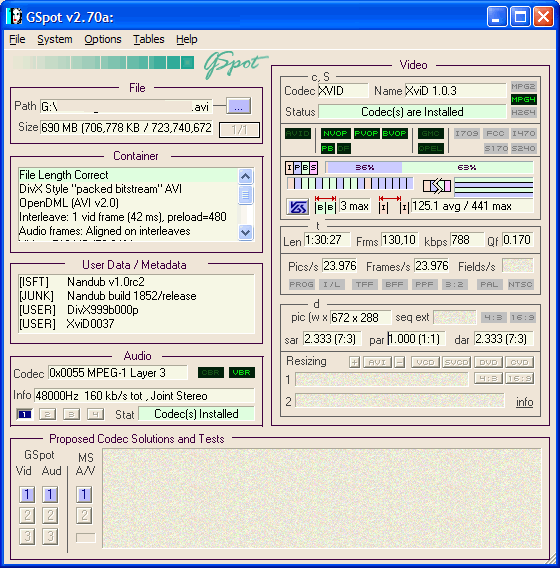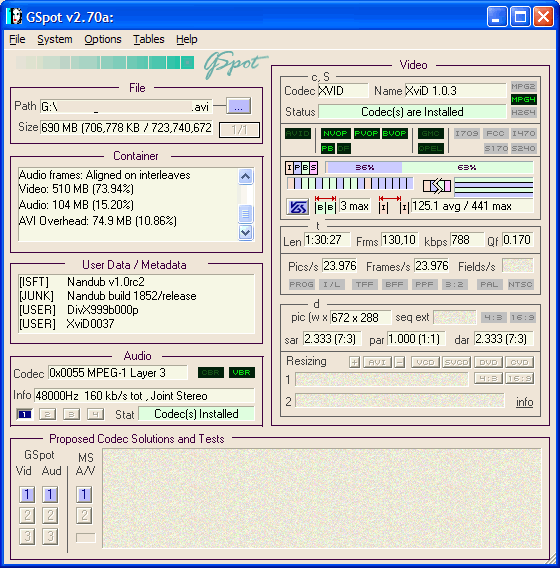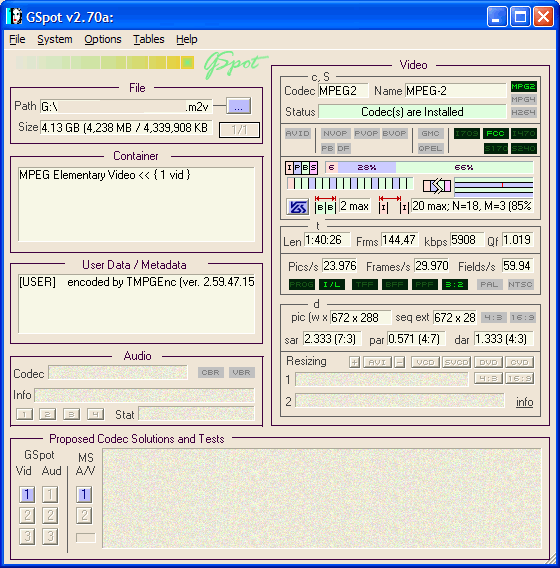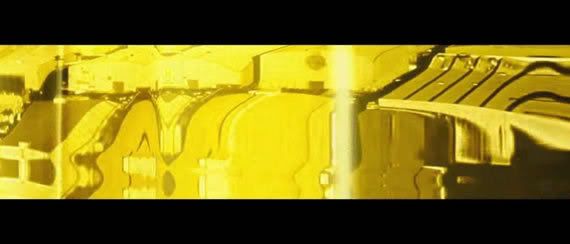I encoded a XviD movie with TMPGEnc, using the settings which are in this file.
When I watched itI guess it's have to do with interlace thing. I choose "3:2 pulldown when playback" as Encode mode because of DVD-Lab (I don't know if this have to do with my problem). Well, for complete report of my settings, you can see the .tpr file in the like above.
- I could clearly see the image flickering in scenes with horizontal lines lines like a door or some furniture.
- I could see the horizontal lines (just like the "scanlines" of arcade games. Dunno if that was the fields which became visible).
- I could clearly see in sloped outlines (like a human shoulder for example) the contour shaped like the "ladders of a stairs" (just like gaming with anti-aliasing off).
I've done a lot of DVD's from XviD movies before I formatted my hard disk (and I've never had this flicker/scanline/non anti-aliased problem; the image quality was always very good). I guess I lost the "good" configurations of TMPEnc when I formatted it.
I'm sure the source XviD movie do not have this image problems (the image quality is fairly good and clear, very different from the result I got in the encoded DVD, and as I said, I've done this a lot of times and it's the first time this happens).
Thanks in advance
PS: sorry for the other topic. My bad.
+ Reply to Thread
Results 1 to 14 of 14
-
-
I'm so noob that I have even heard about this option of resizing filters
 . So I never used this option before in TMPGEnc.
. So I never used this option before in TMPGEnc.
Here is the screenshots you asked for:
XviD 1 (PS: I took two screens for XviD just to show all the content inside "Container" information")

XviD 2

MPEG-2

-
Why is your MPEG file 672x288? To be DVD compatible it should be 720x480. That's probably the source of your problem.
Are you using TMPGEnc Plus, the MPEG encoder? or TDA? If Plus, set the source aspect ratio to 1:1 VGA, and the Video Arrange Method to Full Screen Keep Aspect Ratio. The output aspect ratio can be either 4:3 Display (like you had it set) or 16:9 Display (for an anamorphic encode). I don't know TDA but it probably has similar settings.
TMPGEnc's resizer isn't the best but it's OK. -
Hi jagabo,
I'm using the Plus version, not TDA. I will test right now your tip!! I think that's the "good" setting I used to use (1:1 VGA on source and 4:3 Display on output). Now I went to check the m2v file, and see how it looks in computer:

It's sooo "horizontal"... the ratio looks like 1million:1
See if my thought is correct:
If the original aspect ratio is like that, when watching on my TV (4:3), the movie is so stretched horizontally that we get too much "horizontal information". Is the same as picking 800pixels and stretching it into 400pixels, for example. This way the horizontal lines get overcrowded and thus we have the visible problems I described in the first mesasge.
Am I correct? -
Why is your sample image 574x244? Did you set the Video Arrange Method to Full Screen Keep Aspect Ratio?
Assuming your source is really square pixel then the 672x288 frame is a 2.35:1 aspect ratio film. If you use the settings I gave you, and authored your DVD correctly, the video should look fine on the TV via DVD. -
Nooo, I just resized it to fit in this forum (so the image don't get auto-sized by forum). The original size of the .m2v sample is 672x288, while the original XviD movie is 672x288 but without those black stripes. Yes, I believe that now should work... I'm just waiting for my parents to finish using TV (They're watching City of God) then I will test my sample with the new encode settings. Oh, about your question, yes, this sample was made with Full Screen (keep aspect ratio) but with Source Aspect Ratio 2.11:1 Display. In a few minutes the film should finish then I will test my movie with Source Aspect Ratio 1:1 VGA.Originally Posted by jagabo
BTW, do you know a good place where is explained what's all that Video Source Settings? I choose also "Video source type: Non-interlace (progressive)" in this settings. (most of xvid movies are all non-interlace right?) -
Yes Xvid movies will almost always be progressive.Originally Posted by F u r u y á
With a progressive source the Field Order has no meaning. But with interlaced video each frame contains two pictures. The field order determines which of the two pictures you see first when watching on an interlaced TV.
I've never seen an explanation of the Source Aspect Ratio settings but I believe it's something like this:
1:1 VGA: Pixels are square. Most Xvid/Divx files will use this. With square pixels the display aspect ratio (DAR) is the same as the relative frame dimensions. For example 640x480 is 4:3 (640/480=1.33, 4/3=1.33).
4:3 525 line (NTSC): the 720x480 frame should be displayed as 4:3. The actual pixels have an aspect ratio (w/h) of 0.888...
4:3 525 line (NTSC 704x480): the center 704x480 pixels of a 720x480 frame should be displayed at 4:3. So the full 720x480 frame is a little wider than 4:3. Individual pixels have an aspect ratio (w/h) of 0.9090...
16:9 525 line (NTSC): the 720x480 frame encodes a 16:9 DAR image (anamorphic DVD use this). Individual pixels have an aspect ratio of ~1.18.
The PAL verions are the equivalents for PAL sources.
4:3 Display: the video should be displayed with a 4:3 aspect ratio regardless of what the frame dimensions are.
16:9 Display: the video should be displayed with a 16:9 aspect ratio regardless of what the frame dimensions are.
2.11:1 Display: the video should be displayed with a 2.11:1 aspect ratio regardless of the frame dimensions. MPEG encoding supports this aspect ratio but I don't believe it is DVD legal.
You can see the results of the Video Arrange Methods by previewing the video. In most cases you will want to use Full Screen (Keep Aspect Ratio). -
Thank you jagabo! Didn't know that pixels have w/h ratio too... I tryied the Arrange Methods... now I know why I must set Full Screen Keep Aspect Ratio

And you was right since the beggining!!
I found an old movie here, which was encoded with the "good" settings that I used to use before... and it was in 740x480... and, I tested the two configurations just now (720x480 DVD Standart and 672x288 original movie size) and the difference was enormous! With 720x480, the problems I mentioned disappeared and image quality was very high! Thank you man!Originally Posted by jagabo
Just two more little things:- DVD-Lab always tell me to "Close GOP" in my encoder. How this affect my movie? In TMPGEnc, under MPEG Settings, we have a tab called GOP structure, but I have absolutely no clue in how to change those settings...
- I always set the highest Constant Bitrate I can in TMPGEnc because I have no ideia about 'which XviD bitrate matches MPEG-2 bitrate'... it must have some kind of rule to that but I don't know it. So I set the highest I can, but maybe I'am just wasting bytes and encoding time!
Thank you for your patience and for helping me out!
- DVD-Lab always tell me to "Close GOP" in my encoder. How this affect my movie? In TMPGEnc, under MPEG Settings, we have a tab called GOP structure, but I have absolutely no clue in how to change those settings...
-
Regarding closed GOPs: TMPGEnc has a closed GOP setting -- enable "Output bistream for edit (Closed GOP)".
GOP stands for Group Of Frames. MPEG encoding creates one key frame (like a jpeg image) followed by several "predicted" frames, typically 12 to 15 total. Predicted frames only encode parts of the picture that change from one frame to the next. This is one of the major techniques that reduces the file size. With open GOPs predicted frames can reference frames from outside the GOP. With closed GOPs predicted frames only reference frames within the GOP.
If you are putting long videos (movies) on DVD then you best bet is to use 2-pass VBR with the average bitrate required to fill the disc. You can use a bitrate calculator to get the right bitrate. TMPGEnc Plus will calculate the bitrate for you if you use the Project Wizard.
If you are putting lots of smaller videos on a DVD you can use the single pass constant quality setting. Pick a quality level you find acceptable and encode all your videos at that. The encoder will use whatever bitrate is needed to maintain that quality. Then put as many files as will fit on each DVD. Run a few short test encodes to see what quality you like. I usually use 85. -
Ok, so I will check this option (Closed GOP) next time.
About the bitrates, so we don't have any rule that can tell how much MPEG-2 bitrate we need to match certain amout of XviD bitrate? Example: We have a 100 kbtis/sec XviD video file. An MPEG-2, which will maintain the same quality as this XviD, needs 500 kbtis/sec (so in this example the rule is: MPEG-2 video requieres 5 times more kbits/sec than the XviD video).
I'm using CBR because VBR take a loooong time here (I'm on Athlon XP). Before I own a DVD-RW drive I used 2 pass VBR (to get the highest quality it's possible) and put the movies in two CD's, and also always made overburn! But... really lots of time of encoding (I need to upgrade my PC).
(I need to upgrade my PC).
Didn't know about this single pass...
Thank you Sir! -
MPEG2 for DVD will usually require 2 to 4 times the bitrate of the Xvid file. But this varies depending on many factors such as the frame sizes, the frame rates, the quality of the source, whether you're making a 4:3 or 16:9 anamorphic DVD, etc.Originally Posted by F u r u y á
Similar Threads
-
Horizontal distortion lines
By hyku1147 in forum Newbie / General discussionsReplies: 5Last Post: 27th Nov 2011, 11:02 -
Horizontal Lines Appear In DVD
By Mark-Leon in forum MacReplies: 33Last Post: 17th Oct 2010, 11:23 -
AVerMedia A180 input capture problems - random short horizontal lines
By Rezolution11 in forum Capturing and VCRReplies: 0Last Post: 17th Dec 2008, 15:25 -
horizontal lines in mpeg2
By thecrock in forum Newbie / General discussionsReplies: 6Last Post: 15th Dec 2008, 18:05 -
Help - Horizontal Lines
By Hiram_Abif in forum Newbie / General discussionsReplies: 8Last Post: 9th Aug 2007, 13:06





 Quote
Quote